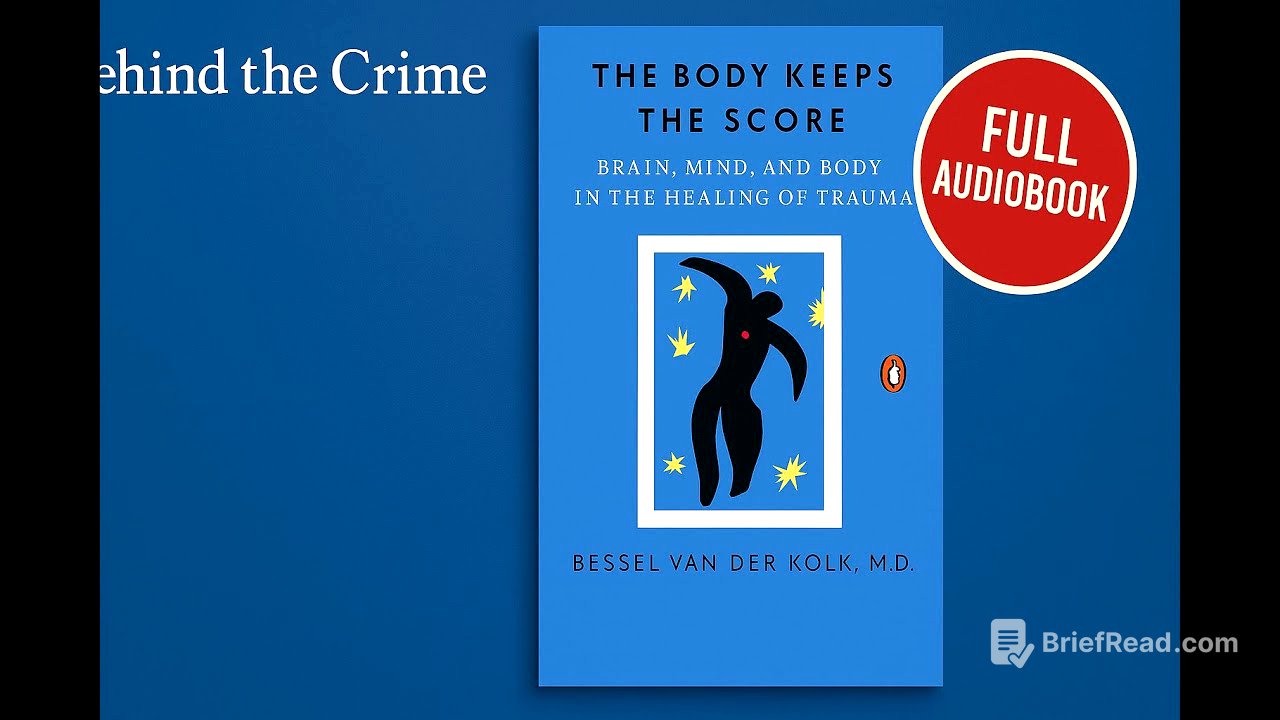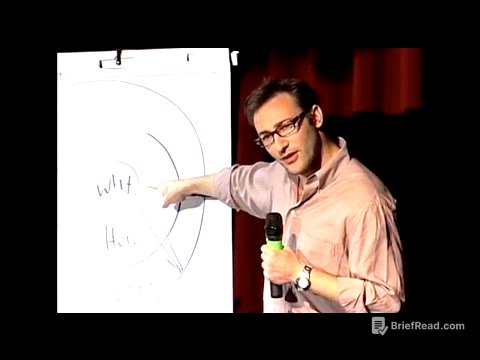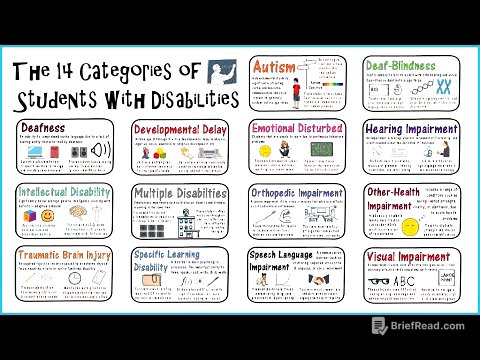TLDR;
This YouTube video transcript discusses the impact of trauma on individuals and society, highlighting the importance of understanding and addressing it through various therapeutic approaches. It covers the physiological changes caused by trauma, the rediscovery of trauma through Vietnam veterans, and the revolutions in understanding the mind and brain. The text also explores the significance of attachment, attunement, and the body-brain connection in healing from trauma, advocating for a shift in diagnostic and treatment approaches to better serve those affected.
- Trauma affects individuals and society profoundly.
- Understanding and addressing trauma is crucial.
- Various therapeutic approaches are highlighted.
- Attachment, attunement, and body-brain connection are significant in healing.
- A shift in diagnostic and treatment approaches is advocated.
Prologue. Facing Trauma [0:30]
Trauma is a common experience, affecting individuals, families, and communities, not just soldiers or refugees. Research indicates high rates of childhood sexual abuse, physical violence, and domestic violence. While humans are resilient, trauma leaves traces on histories, cultures, minds, emotions, biology, and immune systems. It affects not only those directly exposed but also their families, making it difficult to form stable relationships. Trauma is unbearable, leading to denial and requiring tremendous energy to function. The survival brain is not good at denial, reactivating at the slightest hint of danger, causing intense emotions and actions. Survivors fear they are damaged beyond redemption.
Chapter 1, Lessons from Vietnam Veterans [8:34]
The author's first day as a staff psychiatrist at a VA clinic involved treating a Vietnam veteran named Tom, whose experiences highlighted the lasting impact of trauma. Tom suffered from nightmares, flashbacks, and violent tendencies, exacerbated by reminders of Vietnam. Despite outward success, he felt dead inside and disconnected from his family. The author, growing up in postwar Holland, recognised similar behaviours in his father and uncle, both war veterans. Tom's case led the author to prescribe medication for nightmares, but Tom refused, feeling it would dishonour his fallen comrades. This experience made the author realise the complexities of trauma and the need to unravel its mysteries. The author's initial study at the VA involved asking veterans about their experiences in Vietnam, revealing the loss of self and the difficulty in forming intimate relationships.
Chapter 1, Trauma and the Loss of Self [21:26]
The author's study at the VA revealed that many veterans went to war feeling well-prepared and connected, forming close friendships. However, traumatic events, such as ambushes, led to feelings of helplessness, terror, and rage. Tom's experience of witnessing his platoon being killed led to unspeakable acts of revenge, making it impossible for him to return home in any meaningful way. Trauma, whether experienced or inflicted, makes it difficult to engage in intimate relationships, leading to shame and confusion. Numbing is a common symptom, causing emotional distance and a loss of self-recognition. Tom's symptoms were relieved only by intense involvement in a particular case, but the nightmares and rage returned once the case was won.
Chapter 1, The Reorganization of Perception [28:40]
Another study at the VA explored how trauma changes people's perceptions and imagination. Bill, a former medic, experienced unbearable images of dying children in Vietnam after his wife gave birth. He was initially thought to be psychotic, but the author recognised that he was suffering from memories. A Rorschach test revealed that Bill was reliving the trauma in response to an ink blot. The author realised the agony that regularly visited the veterans and the importance of finding a solution. The traumatic event itself had a beginning, a middle, and an end, but flashbacks could be even worse. The author learned that traumatised people have a tendency to superimpose their trauma on everything around them and have trouble deciphering what is going on around them. Trauma also affects the imagination, leading to a loss of mental flexibility and the ability to envision a better future.
Chapter 1, Stuck in Trauma [35:46]
The author started a group for young Vietnam veterans to serve as a holding tank until real therapy could start. In the group, they found resonance and meaning in what had previously been only sensations of terror and emptiness. They felt a renewed sense of comradeship that had been so vital to their war experience. After trauma, the world becomes sharply divided between those who know and those who don't. People who have not shared the traumatic experience cannot be trusted because they can't understand it. The limits of group therapy became clear when the men resisted talking about the issues they confronted in their daily lives. Somehow the very event that caused them so much pain had also become their sole source of meaning.
Chapter 1, Diagnosing Post-Traumatic Stress [38:52]
In the early days at the VA, veterans were labelled with various diagnoses, but it became clear that the treatments were accomplishing very little. A turning point arrived in 1980 when a group of Vietnam veterans successfully lobbied the American Psychiatric Association to create a new diagnosis: post-traumatic stress disorder (PTSD). With the conceptual framework of PTSD in place, the stage was set for a radical change in our understanding of our patients. The author proposed a study on the biology of traumatic memories to the VA, but it was rejected. Unwilling to keep working in an organisation whose view of reality was so at odds with my own, the author handed in his resignation.
Chapter 1, A New Understanding [44:10]
In 1982, the author took a position at the Massachusetts Mental Health Center, where he was confronted with issues he thought he had left behind at the VA. His experience with combat veterans had so sensitised him to the impact of trauma that he now listened with a very different ear when depressed and anxious patients told him stories of molestation and family violence. The author was particularly struck by how many female patients spoke of being sexually abused as children. In many ways, these patients were not so different from the veterans he had just left behind at the VA. They also had nightmares and flashbacks. As we now know, war is not the only calamity that leaves human lives in ruins. In the three decades since the author met Tom, we have learned an enormous amount not only about the impact and manifestations of trauma, but also about ways to help traumatised people find their way back.
Chapter 2, Revolutions in Understanding Mind and Brain [45:51]
In the late 1960s, the author witnessed a profound transition in the medical approach to mental suffering. The goal of the research was to determine whether psychotherapy or medication was the best way to treat young people who had suffered a first mental breakdown diagnosed as schizophrenia. As an attendant, the author had nothing to do with the research aspect of the ward and was never told what treatment any of the patients was receiving. The author spent many nights and weekends on the unit, which exposed him to things the doctors never saw during their brief visits. When patients could not sleep, they often wandered into the darkened nursing station to talk. They shared memories of lying in bed at night helpless and terrified.
Chapter 2, Trauma Before Dawn [48:50]
During morning rounds, the young doctors rarely mentioned stories like the ones the author had heard. The author was often surprised by the dispassionate way patients' symptoms were discussed and by how much time was spent on trying to manage their suicidal thoughts and self-destructive behaviours rather than on understanding the possible causes of their despair and helplessness. A few years later, as a young doctor, the author was confronted with an especially stark example of the medical model in action. The author was then moonlighting at a Catholic hospital doing physical examinations on women who'd been admitted to receive electroshock treatment for depression. On the author's days off from the ward, he often went to the Count Library of Medicine to learn more about the patients he was supposed to help.
Chapter 2, Hallucinations [51:50]
The author came across Eugene Bleuler's 1911 textbook, Dementia Praecox. Bleuler's observations were fascinating. Among schizophrenic body hallucinations, the sexual ones are by far the most frequent and the most important. This made the author wonder if the patients' hallucinations were in fact the fragmented memories of real experiences. There was no question that many patients on the ward engaged in violent, bizarre, and self-destructive behaviours, particularly when they felt frustrated, thwarted, or misunderstood. The author usually followed the lead of the experienced nurses who signalled when to back off or if that did not work to restrain a patient. Sylvia, a 19-year-old student, spoke about her childhood sexual abuse by her brother and uncle. The author realised then our display of caring must have felt to her much like a gang rape.
Chapter 2, Making Sense of Suffering [55:59]
After the author's year on the research ward, he resumed medical school and then returned to MMHC to be trained as a psychiatrist. Seamred taught us that most human suffering is related to love and loss and that the job of therapists is to help people acknowledge, experience, and bear the reality of life with all its pleasures and heartbreak. The greatest sources of our suffering are the lies we tell ourselves, he'd say, urging us to be honest with ourselves about every facet of our experience. Our profession, however, was moving in a different direction. In 1968, the American Journal of Psychiatry had published the results of the study from the ward where the author had been an attendant. They showed unequivocally that schizophrenic patients who received drugs alone had a better outcome than those who talked three times a week with the best therapists in Boston.
Chapter 2, Adaptation or Disease [59:19]
From infinitely variable expressions of intolerable feelings and relationships to a brain disease model of discrete disorders, the way medicine approaches human suffering has always been determined by the technology available at any given time. A major textbook of psychiatry went so far as to state, "The cause of mental illness is now considered an aberration of the brain, a chemical imbalance." The author eagerly embraced the pharmacological revolution. In 1973, the author became the first chief resident in psychopharmacology at MMHC. Antisychotic drugs were a major factor in reducing the number of people living in mental hospitals in the United States. In the 1960s, scientists had begun to develop techniques for isolating and measuring hormones and neurotransmitters in blood and the brain.
Chapter 2, Inescapable Shock [1:04:03]
Preoccupied with so many lingering questions about traumatic stress, the author became intrigued with the idea that the nascent field of neuroscience could provide some answers and started to attend the meetings of the American College of Neuropsychopharmacology (ACNP). In 1984, the ACNP offered many fascinating lectures about drug development. But it was not until a few hours before the author's scheduled flight back to Boston that he heard a presentation by Steven Meyer of the University of Colorado who had collaborated with Martin Seligman of the University of Pennsylvania. His topic was learned helplessness in animals. Meyer and Seligman had repeatedly administered painful electric shocks to dogs who were trapped in locked cages.
Chapter 2, Addicted to Trauma [1:09:13]
The only way to teach the traumatised dogs to get off the electric grids when the doors were open was to repeatedly drag them out of their cages so they could physically experience how they could get away. The author wondered if we also could help my patients with their fundamental orientation that there was nothing they could do to defend themselves. Scared animals return home regardless of whether home is safe or frightening. The author thought about his patients with abusive families who kept going back to be heard again. Traumatised people seem to seek out experiences that would repel most of us. And patients often complain about a vague sense of emptiness and boredom when they are not angry, under duress, or involved in some dangerous activity.
Chapter 2, Soothing the Brain [1:14:28]
Jeffrey Gray gave a talk about the amygdala, a cluster of brain cells that determines whether a sound, image, or body sensation is perceived as a threat. Gray's data showed that the sensitivity of the amygdala depended, at least in part, on the amount of the neurotransmitter serotonin in that part of the brain. That struck the author as an important finding. My patients were always blowing up in response to small provocations and felt devastated by the slightest rejection. The author became fascinated by the possible role of serotonin in PTSD. At that same 1985 meeting, the author learned that drug companies were developing two new products to do precisely that. One of the drugs under investigation never made it to the market. The other was fluoxitine, which under the brand name Prozac became one of the most successful psychoactive drugs ever created.
Chapter 2, The Triumph of Pharmarmacology [1:20:56]
It did not take long for pharmarmacology to revolutionise psychiatry. Drugs gave doctors a greater sense of efficacy and provided a tool beyond talk therapy. Drugs also produced income and profits. The drug revolution that started out with so much promise may in the end have done as much harm as good. The theory that mental illness is caused primarily by chemical imbalances in the brain that can be corrected by specific drugs has become broadly accepted by the media and the public as well as by the medical profession. In many places, drugs have displaced therapy and enabled patients to suppress their problems without addressing the underlying issues. After conducting numerous studies of medications for PTSD, the author has come to realise that psychiatric medications have a serious downside as they may deflect attention from dealing with the underlying issues.
Chapter 2, Adaptation or Disease [1:26:58]
The brain disease model overlooks four fundamental truths. One, our capacity to destroy one another is matched by our capacity to heal one another. Restoring relationships and community is central to restoring well-being. Two, language gives us the power to change ourselves and others by communicating our experiences, helping us to define what we know and finding a common sense of meaning. Three, we have the ability to regulate our own physiology, including some of the so-called involuntary functions of the body and brain through such basic activities as breathing, moving, and touching. And four, we can change social conditions to create environments in which children and adults can feel safe and where they can thrive.
Chapter 3, Looking into the Brain, the Neuroscience Revolution [1:28:06]
In the early 1990s, novel brain imaging techniques opened up undreamed of capacities to gain a sophisticated understanding about the way the brain processes information. For the first time, we could watch the brain as it process memories, sensations, and emotions and begin to map the circuits of mind and consciousness. In 1994, a young psychiatrist, Scott Rouch, was appointed as the first director of the Massachusetts General Hospital Neuroimaging Laboratory. After considering the most relevant questions that this new technology could answer and reading some articles the author had written, Scott asked the author whether he thought we could study what happens in the brains of people who have flashbacks. The author asked eight of them if they would be willing to return to the clinic and lie still inside a scanner, an entirely new experience that the author described in detail while we recreated a scene from the painful events that haunted them.
Chapter 3, A Typical Script [1:31:31]
As any part of the brain became more or less metabolically active, its rate of oxygen consumption would immediately change, which would be picked up by the scanner. We would monitor their blood pressure and heart rate throughout the procedure so that these physiological signs could be compared with brain activity. As she emerged from the scanner, Marca looked defeated, drawn out, and frozen. Her breathing was shallow. Her eyes were opened wide and her shoulders were hunched, the very image of vulnerability and defenselessness. After all eight participants completed the procedure, Scott Rouch went to work with his mathematicians and statisticians to create composite images that compared the arousal created by a flashback with the brain in neutral.
Chapter 3, Picturing the Brain on Trauma [1:34:50]
The biggest area of brain activation, a large red spot in the right lower center of the brain, which is the lbic area or emotional brain, came as no surprise. It was already well known that intense emotions activate the lyic system, in particular, an area within it called the amydala. Our study clearly showed that when traumatised people are presented with images, sounds or thoughts related to their particular experience, the amygdala reacts with alarm. Even as in Marshia's case 13 years after the event, activation of this fear center triggers the cascade of stress hormones and nerve impulses that drive up blood pressure, heart rate, and oxygen intake. Our most surprising finding was a white spot in the left frontal lobe of the cortex in a region called Broca's area.
Chapter 3, Speechless Horror [1:36:32]
Our scans showed that Broca's area went offline whenever a flashback was triggered. In other words, we had visual proof that the effects of trauma are not necessarily different from and can overlap with the effects of physical lesions like strokes. All trauma is preverbal. Under extreme conditions, people may scream obscenities, call for their mothers, howl in terror, or simply shut down. Even years later, traumatised people often have enormous difficulty telling other people what has happened to them. It is enormously difficult to organise one's traumatic experiences into a coherent account, a narrative with a beginning, a middle, and an end. In contrast to the deactivation of Broca's area, another region, Broadman's area 19, lit up in our participants.
Chapter 3, Shifting to One Side of the Brain [1:40:09]
The scans also revealed that during flashbacks, our subjects brains lit up only on the right side. We now know that the two halves of the brain do speak different languages. The right is intuitive, emotional, visual, spatial, and taxual. And the left is linguistic, sequential, and analytical. While the left half of the brain does all the talking, the right half of the brain carries the music of experience. It communicates through facial expressions and body language. The left and right sides of the brain also process the imprints of the past in dramatically different ways. The left brain remembers facts, statistics, and the vocabulary of events. The right brain stores memories of sound, touch, smell, and the emotions they evoke.
Chapter 3, Stuck in Fight or Flight [1:43:58]
What had happened to Marsha in the scanner gradually started to make sense. 13 years after her tragedy, we had activated the sensations, the sounds and images from the accident that were still stored in her memory. When these sensations came to the surface, they activated her alarm system, which caused her to react as if she were back in the hospital being told that her daughter had died. The passage of 13 years was erased. Under normal conditions, people react to a threat with a temporary increase in their stress hormones. As soon as the threat is over, the hormones dissipate and the body returns to normal. The stress hormones of traumatised people, in contrast, take much longer to return to baseline and spike quickly and disproportionately in response to mildly stressful stimuli.
Chapter 3, Each of Which Has Implications for Treatment [1:46:13]
We can focus on the neurochemical and physiological disruptions that were so evident and make a case that she is suffering from a biochemical imbalance that is reactivated whenever she is reminded of her daughter's death. We can also make a strong case that Marca is hypersensitised to her memories of the past and that the best treatment would be some form of desensitisation. However, as we've seen, the experience of trauma itself gets in the way of being able to do that. No matter how much insight and understanding we develop, the rational brain is basically impotent to talk the emotional brain out of its own reality. The act of telling the story doesn't necessarily alter the automatic physical and hormonal responses of bodies that remain hypervigilant, prepared to be assaulted or violated at any time.
Chapter 4, Running for Your Life. The Anatomy of Survival [1:48:18]
On September 11th, 2001, 5-year-old Gnome Saul witnessed the first passenger plane slam into the World Trade Center from the windows of his first grade classroom. He and his classmates ran with their teacher down the stairs to the lobby, where most of them were reunited with parents who had dropped them off at school just moments earlier. Gnome, his older brother, and their dad were three of the tens of thousands of people who ran for their lives through the rubble, ash, and smoke of lower Manhattan that morning. This 5-year-old boy had used his imagination to process what he had seen and begin to go on with his life. Gnome was fortunate. His entire family was unharmed. He had grown up surrounded by love, and he was able to grasp that the tragedy they had witnessed had come to an end.
Chapter 4, Effective Action Versus Immobilization [1:53:42]
Effective action, the result of fight/flight, ends the threat. Immobilization keeps the body in a state of inescapable shock and learned helplessness. If for some reason the normal response is blocked, for example, when people are held down, trapped or otherwise prevented from taking effective action, be it in a war zone, a car accident, domestic violence, or a rape, the brain keeps secretreting stress chemicals, and the brain's electrical circuits continue to fire in vain long after the actual event has passed. Being able to move and do something to protect oneself is a critical factor in determining whether or not a horrible experience will leave long-asting scars. The more neuroscience discovers about the brain, the more we realise that it is a vast network of interconnected parts organised to help us survive and flourish.
Chapter 4, The Brain from Bottom to Top [1:55:33]
The most important job of the brain is to ensure our survival even under the most miserable conditions. Everything else is secondary. Psychological problems occur when our internal signals don't work, when our maps don't lead us where we need to go, when we are too paralysed to move, when our actions do not correspond to our needs, or when our relationships break down. The most primitive part, the part that is already online when we are born, is the ancient animal brain, often called the reptilian brain. It is located in the brain stem just above the place where our spinal cord enters the skull. The reptilian brain is responsible for all the things that newborn babies can do. Right above the reptilian brain is the limbic system. It's also known as the mamalian brain because all animals that live in groups and nurture their young possess one.
Chapter 4, The Triune Three-Part Brain [2:06:18]
Taken together, the reptilian brain and lyic system make up what I'll call the emotional brain. The emotional brain is at the heart of the central nervous system, and its key task is to look out for your welfare. Finally, we reach the top layer of the brain, the neoortex. We share this outer layer with other mammals, but it is much thicker in us humans. The frontal loes are responsible for the qualities that make us unique within the animal kingdom. They enable us to use language and abstract thought. The frontal loes are also the seat of empathy. One of the truly sensational discoveries of modern neuroscience took place in 1994 when in a lucky accident a group of Italian scientists identified specialised cells in the cortex that came to be known as mirror neurons.
Chapter 4, Identifying Danger [2:08:13]
Danger is a normal part of life and the brain is in charge of detecting it and organising our response. Sensory information about the outside world arrives through our eyes, nose, ears, and skin. These sensations converge in the phalamus, an area inside the lyic system that acts as the cook within the brain. The phalamus stirs all the input from our perceptions into a fully blended autobiographical soup. The sensations are then passed on in two directions. Down to the amygdala, two small almond shaped structures that lie deeper in the limbic unconscious brain and up to the frontal loes where they reach our conscious awareness. The central function of the amygdala, which I call the brain smoke detector, is to identify whether incoming input is relevant for our survival.
Chapter 4, Controlling the Stress Response [2:12:16]
If the amygdala is the smoke detector in the brain, think of the frontal loes and specifically the medial prefrontal cortex, MPFC, located directly above our eyes as the watchtowwer offering a view of the scene from on high. As long as you are not too upset, your frontal loes can restore your balance by helping you realise that you are responding to a false alarm and abort the stress response. Effectively dealing with stress depends upon achieving a balance between the smoke detector and the watchtowwer. If you want to manage your emotions better, your brain gives you two options. You can learn to regulate them from the top down or from the bottom up. Knowing the difference between top down and bottom up regulation is central for understanding and treating traumatic stress.
Chapter 4, The Rider and the Horse [2:15:54]
Emotion is not opposed to reason. Our emotions assign value to experiences and thus are the foundation of reason. Our self-experience is the product of the balance between our rational and our emotional brains. When these two systems are in balance, we feel like ourselves. The neuroscientist Paul Mlan compared the relationship between the rational brain and the emotional brain to that between a more or less competent rider and his unruly horse. When people feel that their survival is at stake or they are seized by rages, longings, fear or sexual desires, they stop listening to the voice of reason and it makes little sense to argue with them.
Chapter 4, Timeless Reliving [2:18:46]
On a fine September morning in 1999, Stan and Ute Lawrence set out from their home in London, Ontario to attend a business meeting in Detroit. Halfway through the journey, they ran into a wall of dense fog that reduced visibility to zero in a split second. Stan immediately slammed on the brakes, coming to a standstill sideways on the highway, just missing a huge truck. Stan and Ute were trapped in car number 13 of an 87 car pileup. The worst road disaster in Canadian history. Then came the eerie silence. Stan struggled to open the doors and windows, but the 18-wheeler that had crushed their trunk was wedged against the car. Suddenly, someone was pounding on their roof. A girl was screaming, "Get me out of here."
Chapter 4, Dissociation and Reliving [2:22:03]
Dissociation is the essence of trauma. The overwhelming experience is split off and fragmented so that the emotions, sounds, images, thoughts, and physical sensations related to the trauma take on a life of their own. The sensory fragments of memory intrude into the present where they are literally relived. As long as the trauma is not resolved, the stress hormones that the body secretes to protect itself keep circulating and the defensive movements and emotional responses keep getting replayed. Flashbacks and reliving are in some ways worse than the trauma itself. A traumatic event has a beginning and an end. At some point, it is over. But for people with PTSD, a flashback can occur at any time, whether they are awake or asleep.
Chapter 4, The Timekeeper Collapses [2:27:32]
Stan's brain scan shows his flashback in action. This is what reliving trauma looks like in the brain, the brightly lit area in the lower right hand corner, the blanked out lower left side, and the four symmetrical white holes around the center. Stan's amygdala made no distinction between past and present. It activated just as if the car crash were happening in the scanner, triggering powerful stress hormones and nervous system responses. The two white areas in the front of the brain on top in the picture are the right and left dorsolateral prefrontal cortex. When those areas are deactivated, people lose their sense of time and become trapped in the moment without a sense of past, present, or future.
Chapter 4, The Phalamus Shuts Down [2:30:10]
These are his right and left phalamus, blanked out during the flashback, as they were during the original trauma. As I've said, the phalamus functions as a cook, a relay station that collects sensations from the ears, eyes, and skin and integrates them into the soup that is our autobiographical memory. Breakdown of the phalamus explains why trauma is primarily remembered not as a story, a narrative with a beginning, middle, and end, but as isolated sensory imprints, images, sounds, and physical sensations that are accompanied by intense emotions, usually terror and helplessness. In normal circumstances, the phalamus also acts as a filter or gatekeeper. This makes it a central component of attention, concentration, and new learning, all of which are compromised by trauma.
Chapter 4, Split Off from the Self [2:31:59]
Not all people react to trauma in exactly the same way, but in this case, the difference is particularly dramatic. Since Ute was sitting right next to Stan in the wrecked car, she responded to her trauma script by going numb. Her mind went blank, and nearly every area of her brain showed marketkedly decreased activity. The medical term for UDA's response is depersonalisation. Anyone who deals with traumatised men, women, or children is sooner or later confronted with blank stairs and absent minds, the outward manifestation of the biological freeze reaction. Depersonalisation is one symptom of the massive dissociation created by trauma. The aim is actually to change the patients physiology, his or her relationship to bodily sensations.
Chapter 4, Learning to Live in the Present [2:35:52]
The challenge of trauma treatment is not only dealing with the past, but even more enhancing the quality of day-to-day experience. One reason that traumatic memories become dominant in PTSD is that it's so difficult to feel truly alive right now. When you can't be fully here, you go to the places where you did feel alive, even if those places are filled with horror and misery. We must most of all help our patients to live fully and securely in the present. In order to do that, we need to help bring those brain structures that deserted them when they were overwhelmed by trauma back. Visiting the past in therapy should be done while people are biologically speaking firmly rooted in the present and feeling as calm, safe, and grounded as possible.
Chapter 5, Body Brain Connections [2:36:57]
Darwin starts his discussion by noting the physical organisation common to all mammals, including human beings, the lungs, kidneys, brains, digestive organs, and sexual organs that sustain and continue life. Darwin stands with animal lovers when he proclaims, "Man and the higher animals also have instincts in common. All have the same senses, intuition, sensation, passions, affections, and emotions. Darwin observes that we humans share some of the physical signs of animal emotion. Feeling the hair on the back of your neck stand up when you're frightened or bearing your teeth when you're enraged can only be understood as vestigages of a long evolutionary process. For Darwin, mamleian emotions are fundamentally rooted in biology. They are the indispensable source of motivation to initiate action.
Chapter 5, Darwin's Observations [2:41:08]
Darwin goes on to observe that the fundamental purpose of emotions is to initiate movement that will restore the organism to safety and physical equilibrium. If an organism is stuck in survival mode, its energies are focused on fighting off unseen enemies which leaves no room for nurture, care, and love. Darwin also wrote about bodyb brain connections that we are still exploring today. Intense emotions involve not only the mind, but also the gut and the heart. Heart, guts, and brain communicate intimately via the pneumagastric nerve, the critical nerve involved in the expression and management of emotions in both humans and animals. If Darwin was right, the solution requires finding ways to help people alter the inner sensory landscape of their bodies.
Chapter 5, A Window into the Nervous System [2:42:51]
All of the little signs we instinctively register during a conversation. The muscle shifts and tensions in the other person's face. eye movements and pupil dilation, pitch and speed of the voice as well as the fluctuations in our own inner landscape. Salivation, swallowing, breathing and heart rate are linked by a single regulatory system. All are a product of the synchrony between the two branches of the autonomic nervous system. ANS the sympathetic which acts as the body's accelerator and the parasympathetic which serves as its breakpoint. There is a simple way to experience these two systems for yourself. Whenever you take a deep breath, you activate the SNS. The









